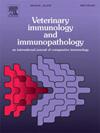Characterization of a lipocalin-like molecule from Dermanyssus gallinae as a potential vaccine antigen
IF 1.4
3区 农林科学
Q4 IMMUNOLOGY
引用次数: 0
Abstract
Poultry red mites (PRMs, Dermanyssus gallinae) are hematophagous ectoparasites of chickens that pose a significant threat to the egg-laying industry. The emergence of acaricide-resistant PRMs raises the demand for alternative control approaches such as vaccination. However, several vaccine antigens have failed to suppress the growth of PRM populations in field trials due to difficulties in maintaining antibody levels. In ticks, the molecules exposed to the host, such as lipocalins, can facilitate antibody production, and are therefore considered advantageous as vaccine antigens. Therefore, we focused on a lipocalin-like molecule (Dg-Lipocalin) identified from an RNA-seq analysis reported by Fujisawa et al. (2020) and analyzed its exposure to the host and potential as a vaccine antigen. Western blotting using 500-fold diluted plasma of chickens from PRM-contaminated farms revealed the presence of antibodies against Dg-Lipocalin, suggesting its exposure to the host. To evaluate its potential as a vaccine antigen, PRMs were artificially fed immune plasma with 32,000- to 64,000-fold antibody titers or plasma from PBS-inoculated control chickens, and their mortality was observed for 7 days. In experiment 1, the immune plasma significantly increased PRM mortality compared to the control plasma. However, these effects were not observed in experiment 2, although the total mortality was significantly increased in immune plasma-fed PRMs. Thus, the efficacy of Dg-Lipocalin appears to be limited; however, its exposure to the host may result in sustained antibody titers. Further investigation is required to evaluate its feasibility.
鸡皮蝇脂钙蛋白样分子作为潜在疫苗抗原的特性研究
家禽红螨(PRMs, Dermanyssus gallinae)是鸡的食血体外寄生虫,对产蛋业构成重大威胁。抗杀螨药PRMs的出现提高了对疫苗接种等替代控制方法的需求。然而,在田间试验中,由于难以维持抗体水平,一些疫苗抗原未能抑制PRM种群的生长。在蜱虫中,暴露于宿主的分子,如脂钙素,可以促进抗体的产生,因此被认为是有利的疫苗抗原。因此,我们将重点放在了Fujisawa等人(2020)报道的RNA-seq分析中鉴定出的脂质钙蛋白样分子(Dg-Lipocalin)上,并分析了其与宿主的接触情况和作为疫苗抗原的潜力。对来自prm污染农场的鸡进行500倍稀释的血浆进行Western blotting,发现存在针对Dg-Lipocalin的抗体,表明其暴露于宿主。为了评估其作为疫苗抗原的潜力,将PRMs人工喂养抗体滴度为32,000至64,000倍的免疫血浆或接种pbs的对照鸡的血浆,并观察其死亡率7天。在实验1中,与对照血浆相比,免疫血浆显著提高了PRM死亡率。然而,在实验2中没有观察到这些影响,尽管免疫血浆喂养的PRMs的总死亡率显着增加。因此,Dg-Lipocalin的功效似乎是有限的;然而,它暴露于宿主可能导致持续的抗体滴度。需要进一步调查以评估其可行性。
本文章由计算机程序翻译,如有差异,请以英文原文为准。
求助全文
约1分钟内获得全文
求助全文
来源期刊
CiteScore
3.40
自引率
5.60%
发文量
79
审稿时长
70 days
期刊介绍:
The journal reports basic, comparative and clinical immunology as they pertain to the animal species designated here: livestock, poultry, and fish species that are major food animals and companion animals such as cats, dogs, horses and camels, and wildlife species that act as reservoirs for food, companion or human infectious diseases, or as models for human disease.
Rodent models of infectious diseases that are of importance in the animal species indicated above,when the disease requires a level of containment that is not readily available for larger animal experimentation (ABSL3), will be considered. Papers on rabbits, lizards, guinea pigs, badgers, armadillos, elephants, antelope, and buffalo will be reviewed if the research advances our fundamental understanding of immunology, or if they act as a reservoir of infectious disease for the primary animal species designated above, or for humans. Manuscripts employing other species will be reviewed if justified as fitting into the categories above.
The following topics are appropriate: biology of cells and mechanisms of the immune system, immunochemistry, immunodeficiencies, immunodiagnosis, immunogenetics, immunopathology, immunology of infectious disease and tumors, immunoprophylaxis including vaccine development and delivery, immunological aspects of pregnancy including passive immunity, autoimmuity, neuroimmunology, and transplanatation immunology. Manuscripts that describe new genes and development of tools such as monoclonal antibodies are also of interest when part of a larger biological study. Studies employing extracts or constituents (plant extracts, feed additives or microbiome) must be sufficiently defined to be reproduced in other laboratories and also provide evidence for possible mechanisms and not simply show an effect on the immune system.

 求助内容:
求助内容: 应助结果提醒方式:
应助结果提醒方式:


